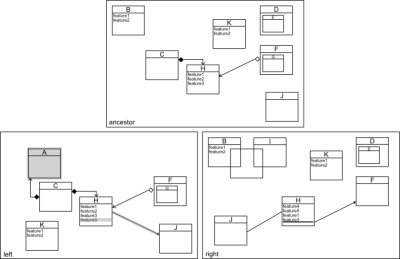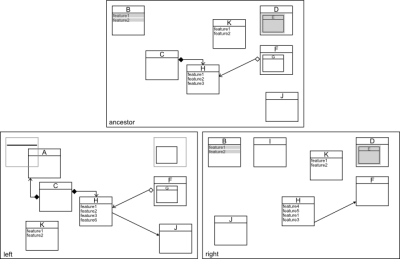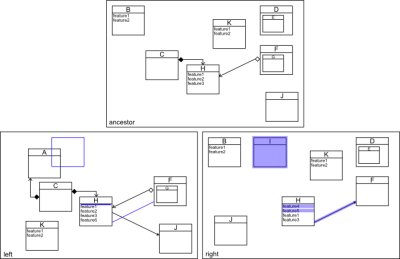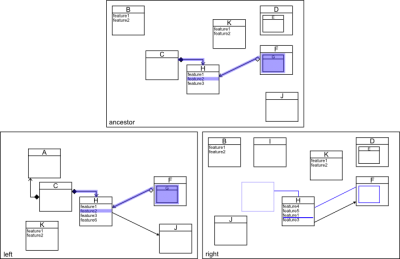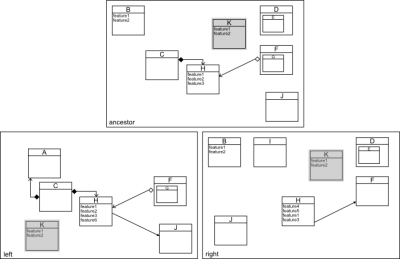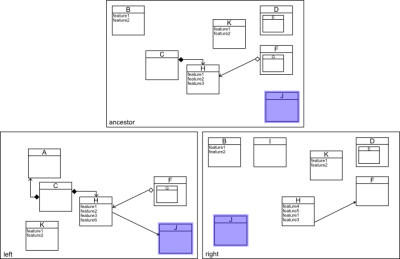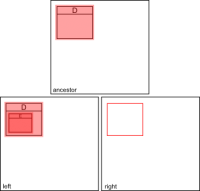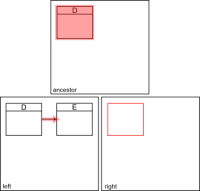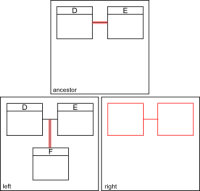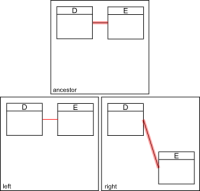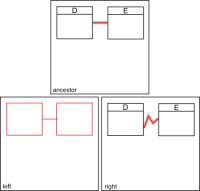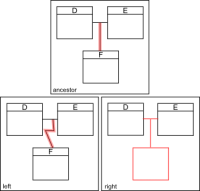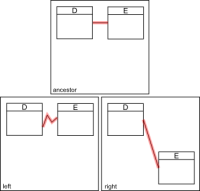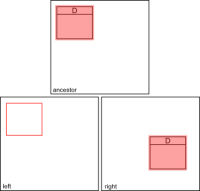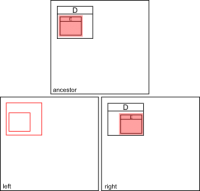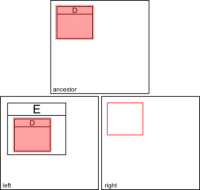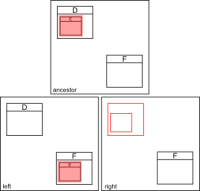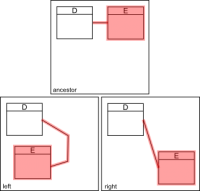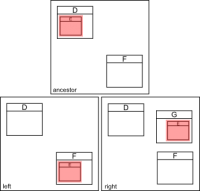Notice: this Wiki will be going read only early in 2024 and edits will no longer be possible. Please see: https://gitlab.eclipse.org/eclipsefdn/helpdesk/-/wikis/Wiki-shutdown-plan for the plan.
EMF Compare/Specifications/GraphicalComparison
Contents
- 1 Evolution Specification: Graphical Comparison
- 1.1 Preamble
- 1.2 Introduction
- 1.3 Detailed Specification
- 1.4 Backward Compatibility and Migration Paths
- 1.5 Tests and Non-regression strategy
- 1.6 Implementation choices and tradeoffs
Evolution Specification: Graphical Comparison
Current status is DRAFT
Preamble
Summary: This feature is about all topics around the comparison of graphical objects.
Links to the Bugzilla tickets which are related to the change:
- Bug 400816 - Phantom display of removed graphical items
Introduction
PENDING This section should contain a summary of the proposed evolution, including why it is needed. Ideally it should be self-contained so that non-developers can get a quick overview of the evolution without reading the detailed specification.
Detailed Specification
The aim is to be the most consistent with the look of the "semantic" comparison (tree).
To put in relief the graphical differences, some decorators should be used.
- On one hand, it enables to focus on the impacted objects, highlighting them with markers.
- On the other hand, through phantoms, it enables to locate either the place where objects were deleted or the target location where objects should be added after merging.
On each difference selection, only the related markers will appear.
About phantoms, if they are nested in other phantoms, these last ones will be displayed on selection of the difference related to the first one. So, to display the context of the phantom eases the understanding of the difference.
Below, different cases are detailed.
Non conflicting cases
- Locally added elements:
|
You can see a locally added object on the left side of the comparison viewer. It is highlighted by a marker in gray color (default color). On the other side, a phantom with the same color is drawn, as place-holder, in order to locate the place where the related object would be added if the end-user merged from left to right. |
- Locally deleted elements:
|
You can see a locally deleted object on the left side of the comparison viewer. It is represented by a phantom in gray color (default value), as place-holder. On the other side, the related object is highlighted by a marker with the same color. On the ancestor version, the origin object is marked too. |
- Remotely added elements:
|
You can see a remotely added object on the right side of the comparison viewer. It is highlighted by a marker in blue color (default color). On the other side, a phantom with the same color is drawn, as place-holder, in order to locate the place where the related object would be added if the end-user merged from right to left. |
- Remotely deleted elements:
|
You can see a remotely deleted object on the right side of the comparison viewer. It is represented by a phantom in blue color (default value), as place-holder. On the other side, the related object is highlighted by a marker with the same color. On the ancestor version, the origin object is marked too. |
- Local coordinates changes:
|
You can see a local coordinate change on the left side of the comparison viewer. The object concerned by this change is highlighted by a marker in gray color (default color). On the other side or the ancestor version, the same object, at the old location, is marked with the same color too. |
- Remote coordinates changes:
|
You can see a remote coordinate change on the right side of the comparison viewer. The object concerned by this change is highlighted by a marker in blue color (default color). On the other side or the ancestor version, the same object, at the old location, is marked with the same color too. |
- Local move (and potentially coordinates change):
|
You can see a moved object from a container to another one, on the left side of the comparison viewer. The object concerned by this move is highlighted by a marker in gray color (default color). On the other side or the ancestor version, the same object, at the old location, is marked with the same color too. |
Conflicting cases
| |
|
|
REMOTE | |||||||||||||||||||||||
| |
|
|
ADD |
DELETE |
Coordinates Change (CHANGE) |
MOVE | ||||||||||||||||||||
| |
|
|
nodes |
children nodes |
parent nodes |
edges |
connected edges |
connected nodes |
nodes |
children nodes |
parent nodes |
edges |
connected edges |
connected nodes |
nodes | children nodes |
parent nodes |
edges |
connected edges |
connected nodes |
nodes |
children nodes |
parent nodes |
edges |
connected edges |
connected nodes |
| LOCAL |
ADD |
nodes |
|
|
|
|
|
|
|
|
|
|
|
|
|
|
|
|
|
|
|
|
|
|
|
|
| children nodes |
|
|
|
|
|
|
|
|
|
|
|
|
|
|
|
|
|
|
|
|
|
|
|
| ||
| parent nodes |
|
|
|
|
|
|
|
|
|
|
|
|
|
|
|
|
|
|
|
|
|
|
|
| ||
| edges |
|
|
|
|
|
|
|
|
|
|
|
|
|
|
|
|
|
|
|
|
|
|
|
| ||
| connected edges |
|
|
|
|
|
|
|
|
|
|
|
|
|
|
|
|
|
|
|
|
|
|
|
| ||
| connected nodes |
|
|
|
|
|
|
|
|
|
|
|
|
|
|
|
|
|
|
|
|
|
|
|
| ||
| DELETE |
nodes |
|
|
|
|
|
|
|
|
|
|
|
|
|
|
|
|
|
|
|
|
|
|
|
| |
| children nodes |
|
|
|
|
|
|
|
|
|
|
|
|
|
|
|
|
|
|
|
|
|
|
|
| ||
| parent nodes |
|
|
|
|
|
|
|
|
|
|
|
|
|
|
|
|
|
|
|
|
|
|
|
| ||
| edges |
|
|
|
|
|
|
|
|
|
|
|
|
|
|
|
|
|
|
|
|
|
|
|
| ||
| connected edges |
|
|
|
|
|
|
|
|
|
|
|
|
|
|
|
|
|
|
|
|
|
|
|
| ||
| connected nodes |
|
|
|
|
|
|
|
|
|
|
|
|
|
|
|
|
|
|
|
|
|
|
|
| ||
| Coordinates Change (CHANGE) |
nodes |
|
|
|
|
|
|
|
|
|
|
|
|
|
|
|
|
|
|
? |
|
|
|
|
| |
| children nodes |
|
|
|
|
|
|
|
|
|
|
|
|
|
|
|
|
|
|
|
|
|
|
|
| ||
| parent nodes |
|
|
|
|
|
|
|
|
|
|
|
|
|
|
|
|
|
|
|
|
|
|
|
| ||
| edges |
|
|
|
|
|
|
|
|
|
|
|
|
|
|
|
|
|
|
|
|
|
|
|
? | ||
| connected edges |
|
|
|
|
|
|
|
|
|
|
|
|
|
|
|
|
|
|
? |
|
|
|
|
| ||
| connected nodes |
|
|
|
|
|
|
|
|
|
|
|
|
|
|
|
|
|
|
|
|
|
|
|
| ||
| MOVE |
nodes |
|
|
|
|
|
|
|
|
|
|
|
|
? |
|
|
|
? |
|
|
|
|
|
|
| |
| children nodes |
|
|
|
|
|
|
|
|
|
|
|
|
|
|
|
|
|
|
|
|
|
|
|
| ||
| parent nodes |
|
|
|
|
|
|
|
|
|
|
|
|
|
|
|
|
|
|
|
|
|
|
|
| ||
| edges |
|
|
|
|
|
|
|
|
|
|
|
|
|
|
|
|
|
|
|
|
|
|
|
| ||
| connected edges |
|
|
|
|
|
|
|
|
|
|
|
|
|
|
|
|
|
|
|
|
|
|
|
| ||
| connected nodes |
|
|
|
|
|
|
|
|
|
|
|
|
|
|
|
? |
|
|
|
|
|
|
|
| ||
| |
Conflict (or pseudo conflict) |
| ? | Is a conflict ? |
| |
Potential pseudo-conflict |
Conflicts
A conflict is created when a change has been made both on left and right side, on the same element.
A graphical conflict can be related to 0 or n semantic conflict.
For example, the change of the coordinates of an object, in local, may be in conflict with an other change of these coordinates on the same object, in remote. However, no conflict (no difference too) exists at the related semantic objects level.
The add of a graphical object (with its semantic one) in a container, on one hand, and the delete of this container, on the other hand, involves conflicts on the both levels.
Also, a semantic conflict may involve no graphical conflict (e.g. on the name of an object).
The conflict devoted markers will be visible only for graphical conflicts.
The markers and phantoms will be drawn according to this rule:
- On the ancestor version, a marker is set down on the object(s) impacted by the conflict.
- On each side, it is the respective change which is put in relief.
If it is a delete of edge inferred by the delete of one of its extremities at least, then phantoms for the related deletions will be drawn too.
If it is a delete of node inferred by the delete of its parent, then a phantom for the parent will be drawn too.
Markers and phantoms:
|
Markers and phantoms:
|
Markers and phantoms:
|
Markers and phantoms:
|
Markers and phantoms:
|
Markers and phantoms:
|
Markers and phantoms:
|
Pseudo conflicts
A pseudo conflict may happen when exactly the same change has been made on both side.
The add of a node/edge on the right and left side may involve a pseudo conflict only if these added elements own the same identifier (in case of manual handling of the XMI source or using of computed functional identifiers).
These pseudo conflicts could be visible in the same way as the "conflict" markers and phantoms, but using a specific color code.
Question about MOVE and CHANGE
- The MOVE of a node may involve a CHANGE (coordinates) of it if the new container requires its own coordinate system.
- So, the MOVE would require the CHANGE. But does the CHANGE require the MOVE ? Because it has no sense outside of the context of the MOVE (to merge the change location whereas the frame of reference is different).
- Is the MOVE in conflict with a CHANGE if the frame of reference is different ?
Required differences
Default behavior
The computation of the required differences from a graphical one inherits from the generic post-processor behavior.
So:
| Change kind |
Reference kind to a graphical object |
Requires: |
| ADD |
content |
|
| reference |
e.g. The ADD of a reference to the target or source of an edge requires the ADD of the edge itself and the ADD of the target and source objects, the ADD of a reference to the semantic object from a graphical one requires the ADD of the graphical and semantic object. | |
| DELETE |
content |
|
| MOVE |
content |
|
| CHANGE |
reference permutation |
|
Specific behavior
PENDING: see with LGO for his modifications on Node and Edge changes.
These cases are already managed by the default requirements post-processor:
- The DELETE of a graphical object is required by the DELETE of the related semantic one ("DELETE object requires DELETE of incoming references" case)
- The DELETE of a graphical object does NOT require the DELETE of the related semantic one.
- MOVE requires and is required by CHANGE if the coordinate system of the new container is relative.
Extension definition and refining
Difference extensions for diagram comparison are defined to encapsulate a set of unitary differences related to the notational model and so to obtain a vision more macroscopic. To summarize, the extensions are refined by other differences.
| Extensions |
Kind |
Refined by: |
| Edge Change | ADD |
|
| DELETE |
| |
| CHANGE |
| |
| MOVE |
N/A | |
| Node Change | ADD |
|
| DELETE |
| |
| CHANGE |
| |
| MOVE |
| |
| Hide Change |
CHANGE |
|
| Show Change |
CHANGE |
|
Merge of extensions
The merge of the graphical extensions consist in merging the potential required differences then the ones refined by the extension.
Each refining difference will merge its required ones before merging itself.
Design
Creation of extensions
Creation of phantoms
Backward Compatibility and Migration Paths
PENDING Every one of the sections below should be present. Even if there is no corresponding change (for example no API change), it should exist to mention explicitly "This evolution does not change any API."
Metamodel Changes
PENDING Document any change to the Viewpoint metamodel. If they require a migration operation, mention it and describe the general idea of how migration process. If any information can be lost during the migration, mention it clearly. If validation rules must be added/modified, mention it also.
API Changes
PENDING List every API addition, removal and deprecation. For each removal and deprecation, indicate the migration path for existing code.
User Interface Changes
PENDING List every user-visible change in the interface. Here "user" includes not only end-users but also developpers.
Documentation Changes
PENDING List every documentation needing an update here, starting by the New and Noteworthy documentation.
Tests and Non-regression strategy
PENDING This part of the document should describe the strategy to use to correctly test the evolution and guarantee the non-regression.
Implementation choices and tradeoffs
PENDING Any important tradeoff or choice made during the implementation should be referenced here with pros/cons leading to the final decision.

